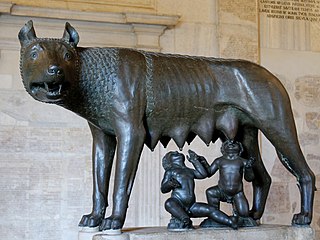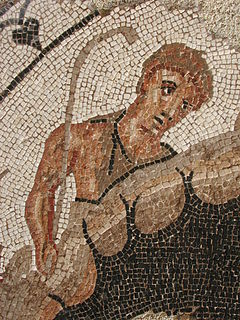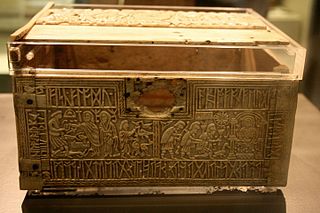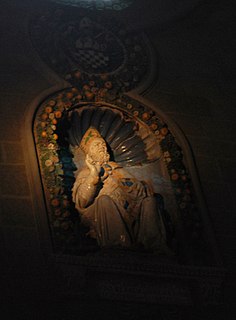 W
WIn the Roman foundation myth, it was a she-wolf that nursed and sheltered the twins Romulus and Remus after they were abandoned in the wild by order of King Amulius of Alba Longa. She cared for the infants at her den, a cave known as the Lupercal, until they were discovered by a shepherd, Faustulus. Romulus would later become the founder and first king of Rome. The image of the she-wolf suckling the twins has been a symbol of Rome since ancient times and is one of the most recognizable icons of ancient mythology.
 W
WThe Ara Pacis Augustae is an altar in Rome dedicated to Pax, the Roman goddess of Peace. The monument was commissioned by the Roman Senate on July 4, 13 BC to honour the return of Augustus to Rome after three years in Hispania and Gaul and consecrated on January 30, 9 BC. Originally located on the northern outskirts of Rome, a Roman mile from the boundary of the pomerium on the west side of the Via Flaminia, the Ara Pacis stood in the northeastern corner of the Campus Martius, the former flood plain of the Tiber River and gradually became buried under 4 metres (13 ft) of silt deposits. It was reassembled in its current location, now the Museum of the Ara Pacis, in 1938, turned 90° counterclockwise from its original orientation so that the original western side now faces south.
 W
WThe Capitoline Wolf is a bronze sculpture depicting a scene from the legend of the founding of Rome. The sculpture shows a she-wolf suckling the mythical twin founders of Rome, Romulus and Remus. According to the legend, when King Numitor, grandfather of the twins, was overthrown by his brother Amulius in Alba Longa, the usurper ordered them to be cast into the Tiber River. They were rescued by a she-wolf that cared for them until a herdsman, Faustulus, found and raised them.
 W
WThe Capitoline Wolf Statue is a sculpture of a she-wolf nursing Romulus and Remus in Cincinnati, Ohio, United States. The bronze sculpture on a granite and marble base is located in Eden Park at the Twin Lakes area overlooking the Ohio River. It is an exact replica of the original Capitoline Wolf in the Musei Capitolini of Rome, Italy.
 W
WThe Capitoline Wolf suckling the twins Romulus and Remus is a symbol of Rome, Italy. The statue was favoured by Italian dictator Benito Mussolini, who donated copies of the statues to various places around the world.
 W
WThe Capitoline Wolf is a monument in Central Chișinău, Moldova. It is located in front of the National History Museum of Moldova.
 W
WThe Column of Antoninus Pius is a Roman honorific column in Rome, Italy, devoted in AD 161 to the Roman emperor Antoninus Pius, in the Campus Martius, on the edge of the hill now known as Monte Citorio, and set up by his successors, the co-emperors Marcus Aurelius and Lucius Verus.
 W
WIn Roman mythology, Faustulus was the shepherd who found the infant Romulus and his twin brother Remus along the banks of the Tiber River as they were being suckled by the she-wolf, Lupa. According to legend, Faustulus carried the babies back to his sheepfold for his wife Acca Larentia to nurse them. Faustulus and Acca Larentia then raised the boys as their own. Romulus later killed King Amulius of Alba Longa and his brother Remus before founding the city of Rome "in the place where they [Romulus and Remus] had been raised."
 W
WThe tale of the founding of Rome is recounted in traditional stories handed down by the ancient Romans themselves as the earliest history of their city in terms of legend and myth. The most familiar of these myths, and perhaps the most famous of all Roman myths, is the story of Romulus and Remus, twins who were suckled by a she-wolf as infants. Another account, set earlier in time, claims that the Roman people are descended from Trojan War hero Aeneas, who escaped to Italy after the war, and whose son, Iulus, was the ancestor of the family of Julius Caesar. The archaeological evidence of human occupation of the area of modern-day Rome dates from about 14,000 years ago.
 W
WThe Franks Casket is a small Anglo-Saxon whale's bone chest from the early 8th century, now in the British Museum. The casket is densely decorated with knife-cut narrative scenes in flat two-dimensional low-relief and with inscriptions mostly in Anglo-Saxon runes. Generally thought to be of Northumbrian origin, it is of unique importance for the insight it gives into early Anglo-Saxon art and culture. Both identifying the images and interpreting the runic inscriptions has generated a considerable amount of scholarship.
 W
WThe Lupercal was a cave at the southwest foot of the Palatine Hill in Rome, located somewhere between the temple of Magna Mater and the Sant'Anastasia al Palatino. In the legend of the founding of Rome, Romulus and Remus were found there by the she-wolf who suckled them until they were rescued by the shepherd Faustulus. Luperci, the priests of Faunus, celebrated certain ceremonies of the Lupercalia at the cave, from the earliest days of the City until at least 494 AD.
 W
WLupercalia was a pastoral festival of Ancient Rome observed annually on February 15 to purify the city, promoting health and fertility. Lupercalia was also known as dies Februatus, after the purification instruments called februa, the basis for the month named Februarius.
 W
WIn ancient Roman religion and myth, Mars was the god of war and also an agricultural guardian, a combination characteristic of early Rome. He was the son of Jupiter and Juno, and he was the most prominent of the military gods in the religion of the Roman army. Most of his festivals were held in March, the month named for him, and in October, which began the season for military campaigning and ended the season for farming.
 W
WThe Palatine Hill, which is the centremost of the seven hills of Rome, is one of the most ancient parts of the city and has been called "the first nucleus of the Roman Empire." The site is now mainly a large open-air museum while the Palatine Museum houses many finds from the excavations here and from other ancient Italian sites.
 W
WIn Roman mythology, Romulus and Remus are twin brothers whose story tells the events that led to the founding of the city of Rome and the Roman Kingdom by Romulus. The killing of Remus by his twin, along with other tales from their story, have inspired artists throughout the ages. Since ancient times, the image of a she-wolf suckling the twins has been a symbol of the city of Rome and the ancient Romans. Although the tale takes place before the founding of Rome around 750 BC, the earliest known written account of the myth is from the late 3rd century BC. Possible historical basis for the story, as well as whether the twins' myth was an original part of Roman myth or a later development, is a subject of ongoing debate.
 W
WSaint Romulus of Fiesole is venerated as the patron saint of Fiesole, Italy. Romulus was probably a local deacon, priest, or bishop of the 1st century.